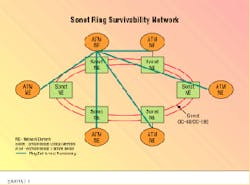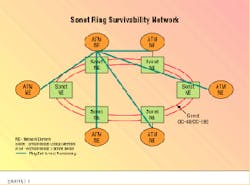Synchronous optical networks harmonize
Synchronous optical networks harmonize
To endow fiber-optic networks that benefit vendors, providers and users alike, the Sonet standards are structured to reconcile existing and expected communications services
Mark Barratt
Fujitsu Network Transmission Systems Inc.
According to industry analysts, synchronous optical networks will enable providers to deliver a variety of digital signals, capacities and services to customers and at the same time, accord vendors with workable standards that will facilitate the design, development and manufacture of reliable communications equipment. These characteristics will result in Sonet technology that can coalesce current and prospective network communication methods.
However, this seemingly optimum scenario is blurred by differing vendor, provider and user viewpoints. For those parties involved in Sonet equipment, services and applications, the market trends and issues that shape their perspective depend on how they perceive the industry.
On the equipment side, a manufacturer might view Sonet technology evolving into new equipment to incorporate additional capabilities. On the applications side, however, customers might consider Sonet as a means to receive a range of two-way interactive communications services.
Among service providers, the regional Bell operating companies and cable-TV companies have different network outlooks. Telephone companies generally see Sonet networks as the future means to offer broadband services. On the other hand, cable-TV companies view Sonet networks as a reliable method for distributing video channels.
The network evolves
During the emergence of Sonet networks, service providers were forced to incorporate network elements furnished by a host of manufacturers. With concepts outnumbering developments, most service providers began implementing fiber-optic cables in their networks to handle day-to-day communications.
Because of the increased capabilities of Sonet, however, the deployment of fiber provided local exchange carriers with more than improved network communications: It endowed networks with an upgradable path for future growth and increased market potential. This same growth approach applied to data service providers and cable-TV companies. In the meantime, service providers could also implement improved networks and services.
With this growth came questions that dealt with Sonet transmission capabilities. These queries related to increased network capacity, reliability, survivability and transmission delays, among others.
To complicate matters further, the priorities for voice, video and data services are different and depend on network requirements. The pressing issue for voice networks is time delay. The data service market`s to¥priority is probably reliability. Video providers are mainly concerned with capacity. Fortunately, Sonet networks provide a platform that meets all these service needs.
Initially, Sonet was created to provide optical transmission rates from 51.84 megabits per second to 2.488 gigabits per second. However, increased network sophistication has resulted in the request for additional rates. Consequently, vendors have developed networking equipment to support speeds from 1.5 Mbits/sec to 10 Gbits/sec. The only limiting performance factors on Sonet network capacity are seemingly high-speed laser technology and fiber modulation limits. The variety of applications that combines voice, data and video appears unlimited.
Perhaps the most important network issues concern reliability and survivability. Telephone providers and customers expect voice service to be functional at least 99.99% of the time. And providers and customers who deal with data transmissions do not hesitate to complain about how lost communications mean lost revenues.
The ring architectures that accompanied the development of Sonet tackled the reliability situation. As fiber-optic communications matured, two standard forms of ring protection were adopted to ensure reliability and survivability. Within milliseconds, unidirectional path-switched rings and bidirectional line-switched rings respond and re-route communications following a fiber cable cut or an equipment failure. Most of the time, customers are unaware that a problem has occurred.
The concern about network operation time delays differs among service providers. Users will tolerate only minimal delay when it comes to voice communications and to certain video applications such as conferencing. Data users, however, do not need immediate response and typically tolerate longer time delays.
For such developing technologies as asynchronous transfer mode, Sonet rings address the time-delay issues by using crossconnections to bypass ATM switches. Instead of sending information from one location to another through a lengthy and speed-debilitating path of switching elements, transmissions can be point-to-point provisioned, thereby eliminating all but two ATM connections. This connectivity method is particularly effective in interoffice communications and applications that require the support of interexchange carriers.
The issue of handling emerging technologies is resolved because Sonet standard formats have been specifically structured to accommodate existing and anticipated technologies. For example, because asynchronous transfer mode technology is considered the switching technology of the future, studies are underway to combine its network communications advantages with those of Sonet`s transmission capabilities.
The Consultative Committee on International Telegraph and Telephone adopted ATM technology several years ago as a worldwide basis for handling new network switching services and capacities. Since then, network providers have sought to combine the benefits of ATM switching and those of Sonet transmission. But two major industry issues cloud the merger: Should Sonet network elements be adapted to offer ATM interfaces? Or should ATM elements be equipped with Sonet transport facilities? The answers depend on the involved company`s market viewpoint.
A Sonet equipment vendor would prefer to have ATM as a service on a Sonet platform. In contrast, an ATM switch vendor would like to see the switch modified to meet transport requirements.
Because the concept of bringing together the capabilities of Sonet networks and ATM are relatively new, those affected by this issue have yet to take sides. Eventually, each side will most likely gather support based on the strengths of its position. Based on that goal, service providers should assess their requirements for choosing one method over another in the same way customers assess their needs before choosing one provider over another.
For example, a customer who wants to send information among Aimes, IA; Akron, OH; and Austin, TX, in a wide area network would probably not turn to a cable-TV company to satisfy those needs. The best source for their requirements would be a service provider experienced in dealing with leased lines and whose strength is network reliability. However, the customer might make the cable-TV service provider the first choice if video conferencing was the preferred communications among those sites.
The same decision process should shake out the issues of combining ATM and Sonet. ATM vendors have an edge in mapping and shipping high-speed packets because of their technology experience, but Sonet vendors have the advantage in providing networks that address such concerns as operations and survivability.
Because these issues, particularly survivability, are paramount to service providers, the telecommunications industry will likely lean toward integrating ATM into Sonet. This movement should force ATM switch vendors to adopt the interface standards of the public network--a requirement that would benefit many telecommunications companies. At the same time, though, Sonet equipment vendors are adopting such ATM services as switching, cell relay and data interfaces.
This adoption entails the incorporation of sufficient ATM features to make the venture worthwhile to customers, who continuously demand more service offerings and improved service efficiencies. With Sonet and ATM working together, networks of the future will be able to support both predicted and unforeseen communications technologies.
Setting the standards
The Sonet standard is about 90% completed. The standards providers deliberately made the rules flexible for equipment vendors to meet evolving standards and to ensure backward compatibility. Without these considerations, such Sonet advancements as defect indicators, performance monitoring, bidirectional line-switched rings and higher transmission rates would have caused serious problems. In addition, most Sonet network adjustments to changing standards can be done through software.
With these flexible standards, such Sonet network equipment as multiplexers, digital-loo¥carriers, transmission and edge-node switches and data interfaces is being installed for a variety of applications.
For example, cable-TV companies are using Sonet networks to transport signals from headends to distribution nodes. They are also using Sonet networks to provide video services and to improve backbone survivability. In some applications, cable-TV companies are competing with the telephone companies to provide telephony services to businesses.
For voice communication providers, Sonet holds the potential for multiplexing thousands of DS-1 lines into an OC-192 network or using bidirectional line-switched rings to connect a private network to a local exchange carrier or an interexchange carrier. q
Mark Barratt is director of strategic planning at Fujitsu Network Transmission Systems Inc. in Richardson, TX.Instead of sending information from one location to another through a lengthy and speed-debilitating path of switching elements, transmissions can be provisioned to go from end point to end point, eliminating all but two ATM connections. This method of connectivity is particularly effective in interoffice communications and applications that require the use of interexchange carriers, while providing the survivability associated with a synchronous optical network ring.

